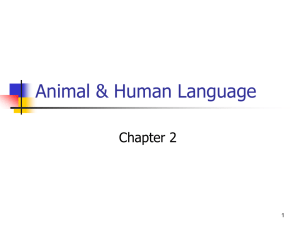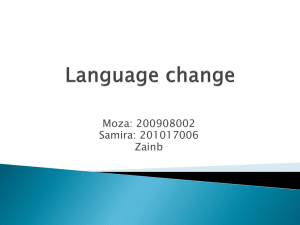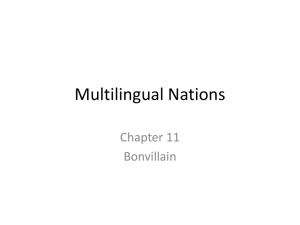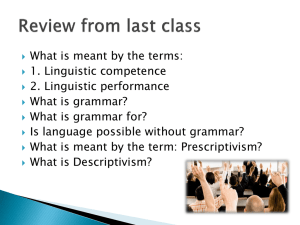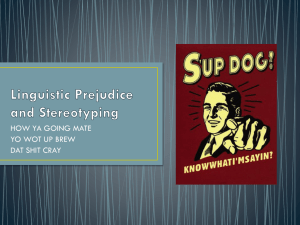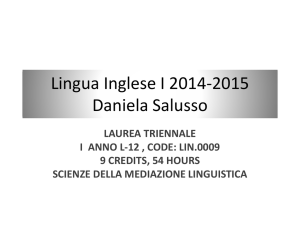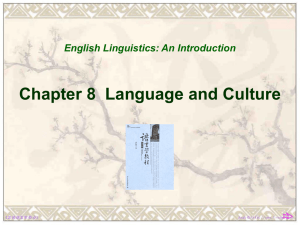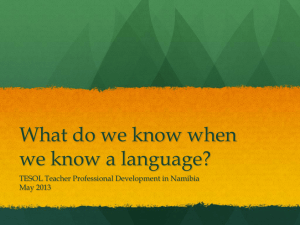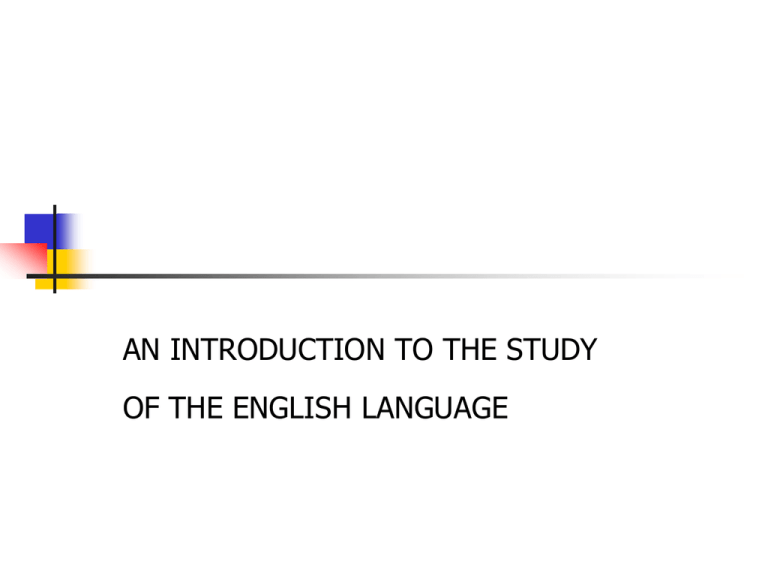
AN INTRODUCTION TO THE STUDY
OF THE ENGLISH LANGUAGE
LINGUISTICS
- the scientific study of all forms of language manifestation
- other related fields of science = applied linguistics
LANGUAGE
= basic means of human communication
-
the most widely used and most convenient means
Man = homo loquens rather than homo sapiens
Convention generally accepted in a speech community
= chain of sounds – acoustic realization to a notion
LINGUISTIC SIGN
The dual nature of linguistic sign:
- notion = non-linguistic world
- its phonetic realization = language phenomenon
Phonetic realization varies from language to language:
dog, Hund, chien, sobaka, kutya, perro, cachorro, pes
SPEECH COMMUNITY
= society (a group of people) using the same language
= agreed to use the same convention
Linguistic signs
- arranged in a grammatical system
- used as a convention in the speech community
The ability to create a system out of signs =
a unique capacity of human beings.
LANGUAGE FAMILIES
More than 4000 languages spoken in the world today:
- classified into several language families
- 2 to 100 or more separate but related languages
Languages diverged from a single ancestoral tongue
= protolanguage
BASIC ENGLISH
British American Scientific International Commercial
English
= reduced and deliberately simplified natural language
In 1927, Charles Kay OGDEN invented BASIC English
as an:
international auxiliary language
-
aid for teaching/learning E. as a second language
BASIC ENGLISH
- limited number of words
- extensive use of paraphrases
850
600
150
100
words:
names of things
names of qualities
“operators“ (Vs + names of acts and directions)
BASIC ENGLISH
Grammatical rules
= cut down to the smallest number necessary for:
-
-
the clear statements of ideas
saying anything for purposes of everyday
existence
BASIC ENGLISH
GRAMMAR:
plural –s
degrees of comparison more, most
adverbs –ly
endings -er, -ing, -ed
negative prefix un-
The core words=theoretically enough for everyday life
BASIC ENGLISH
VOCABULARY
Instead of:
to disembark = to get off a ship,
difficult
weapons
weeping
beloved
to enter the room
to precede
BASIC ENGLISH
OGDEN prescribed additional:
300 words
for general fields of trade, economics, science
350 international words
= general vocabulary of 1500 words.
This core vocabulary extended to a 2000 word list
= any learner should know
BASIC ENGLISH
However, 2 important language facts:
- lexicon = CNs + derivatives not only basic words
- language learning is not only about words
It is about:
- the relations of words to one another
- the relation of signs to meanings.
Language learning is more than rote memory.
COMPOUND WORDS
= 2 words joined together referring to a single object
Each part = used as a separate word but:
the meaning of a compound often differs
from the meaning of its elements.
COMPOUND WORDS
N stem +
Adj stem +
V stem +
Adj stem +
-ing form:
N stem:
N stem:
N stem:
V stem:
COMPOUNDS
with a linking element:
-
vowel/consonant
preposition
conjunction
Lexicalized phrases
COMPOUNDS
a solid yellow stuff made from milk or cream
+
a small insect with two wings
=
an insect with large brightly coloured wings
COMPOUNDS
the planet Earth
+
not narrow
=
spread over all parts
IDIOMS
= a number of words which, when taken together,
have a different meaning from the individual meanings
of each word:
to give someone the green lights
to kick the bucket
a hard / tough nut to crack
IDIOMS
NOUN PHRASES:
the calm before the storm
ADJECTIVE + NOUN:
a fair weather friend
IDIOMS
IDIOMATIC PAIRS
-
of adjectives: spick and span
-
of nouns: ifs and buts
-
of verbs: do or die
IDIOMS
IDENTICAL PAIRS:
step by step
PHRASAL VERBS:
to look sth up
to look up to sb
to look after sb
IDIOMS connected with:
-
parts of the body
to lose one´s head
Achilles´ heel
-
colours:
a black list
white lie
IDIOMS connected with:
- numbers:
ten to one
- time:
at the eleventh hour
- animals:
a busy bee
the lion´s share (of something)
TYPES OF SPEECH
Leonard Bloomfield,
the founder of American structural linguistics:
1) LITERARY STANDARD
= the most formal language manifestation of highly
educated people (unnatural in everyday conversation)
TYPES OF SPEECH
2) COLLOQUIAL STANDARD
= educated people speak / write in informal situation
- not one but different standards for English in Britain:
- colloquial standard spoken with RP
- the Southern type of grammar
TYPES OF SPEECH
2) COLLOQUIAL STANDARD
USA: several standards - according to what is the most
common variety in one or another part of the country
Australia and a few other countries:
= a colloquial standard of their own
TYPES OF SPEECH
3) PROVINCIAL STANDARD
= compared with colloquial standard it shows
only slight phonetic and lexical differences
(something of a kind of funny accent)
TYPES OF SPEECH
4) SUBSTANDARD
= sounds uneducated
= the language of the lower middle class
= less prestigious than either colloquial or provincial
TYPES OF SPEECH
5) LOCAL DIALECT
= used in small parts of the country
= often difficult to understand
It shows:
- phonetic and lexical diversions from other types
- morphological and syntactical differences
= incomprehensible to persons not familiar with it
SLANG
= below the level of educated standard speech
= new words or current words in special sense
= people look down on it but can´t avoid using it
SLANG
Reasons for using it:
to be different
to escape from clichés
to be brief and concise
to enrich the language
to soften a tragedy
to amuse public
to show that one belongs to a certain school
to be secret, not understood by those around
SLANG EXPRESSIONS
donkey´s years
Bugger off!
knick-knack
fishy
SOCIAL VARIANTS OF LANGUAGE
Slang + diminutives + nicknames
= emotional tinge
= manifestations of social closeness and intimacy
SPOKEN LANGUAGE – WRITTEN LANGUAGE
The spoken and written forms – a number changes
Development of the spoken – quicker than written form
English pronunciation =different from spelling
SPOKEN LANGUAGE – WRITTEN LANGUAGE
Phonetic transcription= learning correct pronunciation
The spoken form is based on speech sounds
- more sounds than letters
- no diacritical marks
= to use different means to represent sounds in writing
DIGRAPH= combination of letters represents a sound
SPOKEN ENGLISH – WRITTEN ENGLISH
Sound [ i ] = by different letters or digraphs:
e
ee
ea
ie
ei
ey
i
eo
oe
ae
uay
SPOKEN ENGLISH – WRITTEN ENGLISH
One letter “a“ = different sounds:
[æ]
[e]
[ə]
[a:]
[o:]
[ei]
[i]
SPOKEN ENGLISH – WRITTEN ENGLISH
Homophones:
write – right – rite – wright
Homographs:
(the) wind – (to) wind
Homonyms:
Don´t lie in bed all day. Don´t lie to me.
HINTS ON PRONUNCIATION FOR FOREIGNERS
I take it you already know
Of tough and bough and cough and dough
Others may stumble but not you
On hiccough, thorough, lough and through
Well done! And now you wish, perhaps,
To learn of less familiar traps?
HINTS ON PRONUNCIATION FOR FOREIGNERS
Beware of heard, a dreadful word,
That looks like beard and sounds like bird.
And dead: it´s like bed, not bead –
For goodness sake don´t call it “deed“.
Watch out for meat and great and threat
(They rhyme with suite and straight and debt)
THE PROPERTIES OF HUMAN LANGUAGE
LANGUAGE = convention used for communication
among speakers belonging to a speech community.
All creatures = communicate - members of their species
Properties differentiating human language and
make it a unique type of communication system:
THE PROPERTIES OF HUMAN LANGUAGE
1) DUALITY = the dual nature of linguistic structure
LINGUISTIC FORMS:
significant units of sounds (phonemes)
+ significant units of forms (morphemes)
The arrangement of phonemes
= meaningful in a linguistic form
THE PROPERTIES OF HUMAN LANGUAGE
SPEECH PRODUCTION:
- the physical level = individual sounds:
n, b, i = distinct sounds
- another level = meaning, i.e. sounds in combinations:
bin, or nib = distinct meanings
THE PROPERTIES OF HUMAN LANGUAGE
DUALITY OF LEVELS (“double articulation“)
= one of the most economical features of language:
limited set of distinct sounds = sound combinations
distinct in meaning (words)
THE PROPERTIES OF HUMAN LANGUAGE
2) PRODUCTIVITY (creativity, open-endedness)
= to combine structural elements of the language
into combinations - understood by other members:
child learning language; adults describing new objects
= create new expressions, sentences,novel utterances
The productivity of human language = infinite
THE PROPERTIES OF HUMAN LANGUAGE
3) ARBITRARINESS
= no direct relation or “natural“ connection
between a notion and its phonetic shape
The phonetic realization of a notion = arbitrary,
a matter of convention.
Property of linguistic signs = their arbitrary relationship
with the objects they are used to indicate
THE PROPERTIES OF HUMAN LANGUAGE
4) INTERCHANGEABILITY
= in communication members of a speech community both send and receive messages
Any speaker / sender of a linguistic sign =
a listener / receiver
THE PROPERTIES OF HUMAN LANGUAGE
5) SPECIALIZATION
Every human language = a special system
made up for communication in a speech community.
Linguistic signals = special, not for breathing or feeding
THE PROPERTIES OF HUMAN LANGUAGE
6) DISPLACEMENT
- to speak in a direct context = of things present
+ things not existing at all
- to refer to past or future time,
- to other locations
THE PROPERTIES OF HUMAN LANGUAGE
DISPLACEMENT
allows the human-language user:
-
to create fiction
-
to describe possible future world
= understood by persons familiar with these notions
THE PROPERTIES OF HUMAN LANGUAGE
7) DISCRETENESS
Sounds used in language = meaningfully distinct,
e.g. a slight difference between b + p sound
The pronunciation of forms: back and pack
leads to a distinction in meaning
= due to the difference between b and p sound
Each sound in the language is treated as discrete.
THE PROPERTIES OF HUMAN LANGUAGE
8) CULTURAL TRANSMISSION
Every human being = ability to use language
= to learn mother tongue + other languages
A language = also the speech community,
its members, its history, its culture
Development of language - influenced human culture,
and vice versa.
THE PROPERTIES OF HUMAN LANGUAGE
Non-linguistic culture + language exist side by side,
depend upon each other = interdependent
You may:
inherit brown eyes and dark hair from your parents
(but not language)
You will:
acquire a language in a culture with other speakers
(not from parental genes)
SPEECH ACTS
A SPEECH ACT
a manifestation of speaker´s communicative
activity
an act of verbal (spoken or written) behaviour.
Its realization makes up the utterance
which has certain illocutionary force.
SPEECH ACTS
In spoken English:
tendency to free the borders between speech acts of:
stating
inquiring
directing of the addressee.
SPEECH ACTS
question = polite request; command = good advice;
Can you help me, please?
= Please, help me immediately. (urgent demand)
I think he understands what I mean.
= Does he really understand what I mean? (uncertainty)
Don´t worry he will be all right in a couple of
days.
= You should not be upset about his illness (good advice)
SPEECH ACTS
Declarative questions and polite requests =
a specific function in English conversation:
- express: uncertainty, hesitation, non-imposition
You seem to realize how difficult it is to study
medicine. (declarative question)
Do you realize how difficult it is to study medicine?
I would be very pleased to meet you again.
(polite request)
Will it be possible to meet you again?
POLITE REQUESTS
- according to their syntactic structure = questions
- according to their meaning = polite requests
= more polite and acceptable than the imperative:
SHOW ME THE WAY TO THE MUSEUM (PLEASE)
- rarely used to issue requests
PLEASE SHOW ME THE WAY TO THE MUSEUM
- a direct speech act (too urgent)
POLITE REQUESTS
Sentences indirectly doing requests – with:
Would – Will – Could – Can
Short questions (pre-requests)
= a preparatory phase for expressing the full request:
MAY I ASK YOU FOR SOMETHING?
COULD YOU DO ME A FAVOUR?
FORMALITY vs. INFORMALITY
The character and choice of language expressions
depend on the relation between:
a sender and a receiver of a message.
- it differs according to: whom we communicate
FORMALITY vs. INFORMALITY
The opposition of formality and informality
= a continuum with several interphases:
posh talk
distance
familiar tone
spontaneous, informal chat
relaxed conversation
FORMALITY vs. INFORMALITY
The relation expressed between a sender and a receiver
of a message, e.g.:
I appreciate your kind offer and support.
It´s very kind of you to give me the backing.
Nice of you to back me up.
FACTORS OF FORMALITY
FORMAL:
complex sentences
polysylabic, classical vocabulary:
investigate, extinguish
POLITE:
respectful terms of address: Sir
indirect requests: Would you be so kind as to ...
IMPERSONAL:
passive voice: the terrorists were shot
third person noun phrases:the reader, customers
FACTORS OF INFORMALITY
INFORMAL:
simple sentences
monosyllabic, native vocabulary, esp. phrasal verbs:
look into, put out
FAMILIAR:
intimate terms of address: John, love,
direct imperatives: Give me ...
PERSONAL:
active voice: police shot the terrorists
1st and 2nd person pronouns: I, you,
FORMAL EXPRESSION:
A high percentage of those who claim that
public schools are an anachronism have an
ideological objection to schooling that is funded
by private individuals rather than the state.
INFORMAL EXPRESSION:
VARIETIES OF ENGLISH
Every language = more than 1 variety
STANDARD (“correct, pure“) ENGLISH = used in:
books and newspapers
mass media
schools
Social point of view: THE STANDARD LANGUAGE =
socially prestigious dialect originally connected with
a political or cultural center (London for BE; Paris for Fr)
VARIETIES OF ENGLISH
Every language-user speaks with an accent.
The term ACCENT:
= description of aspects of pronunciation
= identification of where a speaker is from,
socially or regionally
VARIETIES OF ENGLISH
The term DIALECT:
= pronunciation + grammar + vocabulary
You don´t know what you´re talking about.
= in StandE with a Scottish accent
(generally understood)
Ye dinnae ken whit yer haverin´aboot.
= in Scottish dialect
(not generally understood - differences in P, V, Gr)
1 VARIETIES ACCORDING TO REGIONS
- realized mostly in phonology:
first a speaker´s pronunciation is recognized
then his distinctive vocabulary and grammar
Geographical dispersion = basis for linguistic variation:
THE BRITISH ISLES
NORTH AMERICA
1 VARIETIES ACCORDING TO REGIONS
THE BRITISH ISLES:
Irish, Scots, Northern, Midland, Southwestern, Welsh, London varieties of English
NORTH AMERICA:
Canadian, New England, Midland, Southern
varieties of English
1 VARIETIES ACCORDING TO REGIONS
INVESTIGATION of regional dialects:
the identification of consistent features of speech
found in one geographical area rather than another
The aim of DIALECT SURVEYS:
to find significant differences in the speech
of those living in different areas
to be able to chart the boundaries between the areas
1 VARIETIES ACCORDING TO REGIONS
ISOGLOSS
= the line representing a boundary between the areas
with regard to particular linguistic items
= the limit of an area - a linguistic feature is used
Northern dialect area: Minnesota, N./S. Dakota, Northern Iowa:
taught [o]/; paper bag; get sick;
Midland dialect area: Iowa, Nebraska:
taught [a]; paper sack; take sick;
1 VARIETIES ACCORDING TO REGIONS
Drawing isoglosses and dialect boundaries = useful but:
in most areas one variety merges into another
Regional variations exist along a dialect continuum
= not sharp breaks from one region to the next
When - countries, e.g.:
SCANDINAVIAN dialect continuum
1 VARIETIES ACCORDING TO REGIONS
The SCANDINAVIAN dialect continuum:
= across different languages - different countries
Speakers of Norwegian and Swedish:
- use different dialects of a single language
- bidialectal speakers (speaking two dialects)
The speaker speaking two languages = bilingual
1 VARIETIES ACCORDING TO REGIONS
In CANADA, an officially bilingual country:
official languages:
ENGLISH (essentially an English-speaking country) +
FRENCH = a French-speaking minority group (Quebec)
Individual bilingualism:
- mother speaking English, father – French
- child = both languages not noticing disctinctions
- 1 language = dominant, the other = subordinate role
2 VARIETIES ACCORDING TO EDUCATION
Educated speech (Standard English)
spoken by government, the learned professions,
the law court, political parties, the press,
RECEIVED PRONUNCIATION (RP)
standard, non-regional, of considerable prestige
Uneducated speech (substandard form)
identified with regional dialect (I don´t want no cake)
3 VARIETIES ACCORDING TO SUBJECT
A speaker may choose to speak:
- in a national standard
- in a regional dialect
The switch = turn to particular set of lexical items
for handling the subject in question, e.g.:
law, cookery, engineering, football
A particular subject matter – roughly constant
for the type of language, e.g.:
legal sentence = educated variety of English
4 VARIETIES ACCORDING TO MEDIUM
spoken:
stress, rhythm, intonation, tempo, gestures
written:
- the absence of the person addressed
- careful and precise completion of sentences
5 VARIETIES ACCORDING TO ATTITUDE
= stylistic varieties
Linguistic form depends on our attitude to:
the hearer (reader)
the subject matter
the purpose of our communication
Sentences:
informal (friendly)
formal (impersonal)
6 VARIETIES ACCORDING TO INTERFERENCE
refer to the trace left by someone´s native language
upon the foreign language he has acquired, e.g.:
„I am here since Monday.“
= the Frenchman / the Slovak imposes a French /
Slovak grammatical usage on English
INTERFERENCE
= linguistic disturbance which results from two
languages coming into contact in a specific situation
VARIETIES OF ENGLISH
From a linguistic point of view:
no variety is “better“ than another, they are simply different.
The varieties involved on the common core of English:
- American and British English
- speech and writing
- formal and informal
LANGUAGE PLANNING
Government, legal and educational bodies:
- plan which language varieties spoken in the country
are to be used for official business
- do some type of language planning
LANGUAGE PLANNING
THE LANGUAGE PLANNING:
- selection: chosen official language
- codification: basic grammar, dictionaries, written
models are used to establish the Standard variety
- elaboration: Standard use in all aspects of social life
- implementation: government encourages its use
- acceptance: population - use the Standard as the
national language
= plays a part in social as well as in national identity
LANGUAGE – INDIVIDUAL – SOCIETY
LANGUAGE
= both an individual and social phenomenon
= most important link between an individual and society
An individual uses language as a functioning member
of a social group – a speech community
If not a language - no thorough communication
among individuals
LANGUAGE – INDIVIDUAL – SOCIETY
ENGLISH LANGUAGE is composed of dialects
DIALECTS
- develop because language is constantly changing
- defined by geographical barriers (mountains, rivers) =
difficult communication
The Atlantic Ocean prevented easy and frequent communication.
Based on the speech of England in 17 ct. two distinct
dialects – BE and AE – were developed
LANGUAGE – INDIVIDUAL – SOCIETY
Each person = his own way of expressing himself,
- slight differences enable to communicate freely
with other members of the same speech community
IDIOLECT:
- an individual´s total set of language habits;
the personal dialect of each individual language speaker
LANGUAGE – INDIVIDUAL – SOCIETY
IDIOLECT
- determined by the social factors + other factors
(voice quality, physical state)
“YOU ARE WHAT YOU SAY“
Every idiolect differs from others.
The idiolects of individuals in close contact = similar,
but never identical
The greater density of communication = the more similar idiolects
LANGUAGE – INDIVIDUAL – SOCIETY
Members of social groups:
- share the same interest
- work in the same field
= influence each other, e.g. idiolect of a teacher
Every job = a certain amount of jargon difficult to understand,
e.g. the waiter´s call at a lunch counter:
„Bucket of mud, draw one, hold the cow.“
= a variation on the customer´s order for: ...
LANGUAGE – INDIVIDUAL – SOCIETY
The same social class but differences acc. to age / sex:
- teenagers: fridge;
grandparents: icebox
- female: I did, he isn´t;
male: I done, he ain´t
At present, the factor influencing the idiolect:
= language manifestation in the means of mass media
- sounds educated
- more prestigious and respected
IDIOLECTS = becoming more and more similar
IDE FAMILY OF LANGUAGES
= historically related groups of languages
= a closer kinship to one another
Most languages = hypothetical speech ancestor:
INDO-EUROPEAN
- its descendent lg-s = half of the world´s population
The original form of the language (PROTO) =
source of modern lg-s in Indian sub-continent + Europe
DIVISION OF IDE FAMILY
The different pronunciation of the initial velar or
guttural “k“ sound in the word meaning “hundred“:
CENTUM (western)
SATEM (eastern)
= a hard sound:
= a softer sound:
Hundert, ...
sto, ...
IDE FAMILY OF LANGUAGES
CENTUM (western)
SATEM (eastern)
GERMANIC
BALTO-SLAVIC:
NORTH G.:
BALTIC: Latvian, Lithuanian
Norwegian
SLAVIC: East: Russian, Byelorussian, Ukrainian
Swedish
West: Slovak, Czech, Polish
Icelandic
South: Bulgarian, Slovenian, Croatian, Serbian
Danish
ARMENIAN: Armenian
EAST G. – Gothic
ALBANIAN: Albanian
WEST G.: English, German, Dutch
INDO-IRANIAN:
HELLENIC: Ancient Gr.– Mod. Greek
Indic – Sanskrit: Bengali, Panjabi, Hindi,
CELTIC: Welsh, Irish, Gaelic
Nepali, Urdu
ITALIC - Latin:
Iranian – Old Persian – Persian, Kurdish,
Italian, French, Spanish, Portuguesse,
Romanian
IDE FAMILY OF LANGUAGES
The proto-language reconstructed by comparison
of sounds + forms of lg-s in written documents
DIACHRONIC STUDY
= study of the history of language development
SYNCHRONIC STUDY
= study of the description of contemporary language
IDE FAMILY OF LANGUAGES
Old Norse:
einn, steinn
Gothic:
ains, stains
Old High German: ein, stein
Old English:
ᾱn, stᾱn
Conclusion: Proto-Germanic forms of English
one < *ainaz
stone < *stainaz
These forms prove the mutual relationship of the compared
Germanic languages in the given point of their system.
IDE FAMILY OF LANGUAGES
Comparative research = comparing Germanic lg-s
+ Slavonic, Baltic, Celtic, Indo-Iranian, Latin, etc.
- similarities in phonic and grammatical structures =
hypothesis:
All the languages – originated from a common source,
a proto-language = INDOEUROPEAN, e.g.:
*mᾱter, *dwo, * trējes
IDE FAMILY OF LANGUAGES
CENTUM (western)
NORTH GERMANIC
Icelandic: tvo, θri
Swedish: tva, tre
WEST GERMANIC
German: zwei, drei
Dutch: twee, drie
English: two, three
EAST GERMANIC
Gothic: twai, θreis
SATEM (eastern)
INDIC
Sanskrit: dvau, trayas
BALTIC
Lithuanian: du, trýs
SLAVONIC
Russian:
Polish:
Croatian:
Slovak:
IDE FAMILY OF LANGUAGES
Germanic branch = TEUTONIC
GOTHIC = extinct language;
- known mostly from a 4th ct edition of the Bible
- very important as a linguistic tool for understanding
early developments in the entire language branch
ENGLISH – developed from the western Germanic tribes
Saxons, Jutes, Angles – the name EN derived from
IDE LANGUAGES
The two main common features:
- they are inflectional in structure
syntactic distinctions (C, G, Nr, mood, tense) are indicated
by varying the form of the word, e.g -s (pl); -ed (past tense)
- they have a common word-stock
NON-IDE LANGUAGES – not inflectional system
ISOLATING, e.g. Chinese:
mostly monosyllabic words, relation indicated - by WO
AGLUTINATIVE, e.g. Hungarian, Turkish
affixes attached to bases (Barát-om-nak = to a friend)
INCORPORATING / POLYSYNTHETIC, e.g. Eskimo
(lg of Greenland) a single word expresses S, V, Od, Oi
= a sentence of 5-6 words = “incorporated“ as a single word
NON-IDE FAMILIES OF LANGUAGES
FINNO-UGRIAN:
Finnish, Hungarian, Lappish
ALTAIC:
Turkish, Mongolian, Manchu
HAMITIC:
African languages (Egyptian)
SEMITIC:
Hebrew, Arabic
NON-IDE FAMILIES OF LANGUAGES
INDO-CHINESE:
in Tibet, Burma, China
MALAY-POLYNESIAN:
in Philippines, Malay Peninsula, Madagaskar
AMERICAN INDIAN FAMILIES – largest groups:
Iroquoian, Siouan, Uto-Aztecan
IDE FAMILY TREE
- covers a small number of languages
30 language families
4000 languages spoken
Number of speakers:
Mandarin Chinese (more than 400 million)
English (300 million)
Russian, Spanish (200 million each)
COGNATES
Close similarities in sets of terms =
within groups of related languages
COGNATES:
two words in different languages which are similar
in form and meaning
COGNATES
English: mother, father, friend = cognates of
German: Mutter, Vater, Freund
= common ancestor in the GERMANIC BRANCH of IDE
COGNATES
Spanish: madre, padre, amigo = cognates of
Italian: madre, padre, amico
= common ancestor in the ITALIC BRANCH of IDE
MAIN ASPECTS OF THE HISTORY OF ENGLISH
- linguistic influences on English
CELTIC BRANCH OF LANGUAGES
Britonnic/British:
WELSH
BRETON
CORNISH of Cornwall (died out)
Gaelic:
IRISH GAELIC – by country folk in the NW of Ireland
SCOTTISH GAELIC – in the Highlands in Scotland
MANX (died out)
Gaulish – died out
1) CELTIC LANGUAGE INFLUENCE
CELTIC = 1st IDE language spoken in England
Celtic tribes, the BRITONS (btw 6th – 3rd ct. B.C.)
invaded the islands and overcame the Iberians
The southern part of the island named after them:
BRITAIN
1) CELTIC LANGUAGE INFLUENCE
Words of CELTIC origin in ModE:
- geographical names:
Avon (in Celtic: river)
Derwent (clear water)
the Downs (the chalk highlands in the S and S-E)
the river Thames
- town names: London, Leeds, Dover
2) LATIN LANGUAGE INFLUENCE
LATIN
when Britain (ex. Scotland) a province of Roman Empire
1st -5th ct A.D.: establishment of Latin as the language
of administration, law, the Church
LATIN did not replace the CELTIC language in Britain.
Roman legions left Britain in 407 A.D.
2) LATIN LANGUAGE INFLUENCE
Words of LATIN origin in ModE:
street (strata), port (portus), wall (vallum),
wine (vinum), market (mercatus)
Roman towns – strongly fortified, called castra (camp)
English town names ending in: chester, cester, caster:
Chester, Winchester, Manchester, Colchester
Leicester, Gloucester, Doncaster, Lancaster;
Lincoln = from Latin colonia (colony)
3) GERMANIC LANGUAGE INFLUENCE
Germanic tribes of SAXONS, ANGLES and JUTES
(now: the Netherlands, Denmark and Germany)
attacked the country in the middle of 5th ct (449)
-
closely akin in speech and customs
merged into one people: the ANGLO-SAXONS
made up the majority of the population
their customs and language = predominant
called the Celts wealas (welsh) = foreigners
3) GERMANIC LANGUAGE INFLUENCE
The CELTS (the minority):
merged with the conquerors
learned to speak their language
The CELTS in W. Scotland + Ireland = native language
CELTIC = Gaelic = Scottish Gaelic, Irish Gaelic
3) GERMANIC LANGUAGE INFLUENCE
The conversion of the Anglo-Saxons to Christianity =
a revival of learning:
Greek: arithmetics, maths, theatre, geography
Latin: school, paper, candle, devil, mental, monk,
cap, spade, mill, tile, mortar, marble, chalk
3) GERMANIC LANGUAGE INFLUENCE
Seven (Germanic) kingdoms: the HEPTARCHY
Northumbria, Mercia, East Anglia, Kent, Essex,
Sussex, Wessex
Kingdom of Wessex and its capital Winchester in 9 ct =
centre of learning – the reign of King Alfred (the Great)
- translations of books on religion, history, philosophy from Latin
into ANGLO-SAXON (hand written copies in monasteries)
3) GERMANIC LANGUAGE INFLUENCE
The main dialects:
Northumbrian, West Saxon, Kentish, Mercian,
= direct ancestor of ModE
Mercian + Northumbrian grouped: Anglian dialect
Most of the literary documents (10th – 11th ct) survived
in later West-Saxon versions - some Anglian features
3) GERMANIC LANGUAGE INFLUENCE
6 ct. Latin writers – began to refer to Anglo-Saxons as
ANGLI/ENGLI (the Angles)
7 ct. Latin name ANGLI/ANGLIA – for the country around 1000
ENGLALAND (= land of the Angles)
the nation: ANGELCYNN (= nation of the Angles)
the language: ENGLISC (= English)
Some references = ANGLO-SAXON LANGUAGE
OLD ENGLISH (language period 600/700 – 1100)
4) SCANDINAVIAN INFLUENCE
- in 787: invasion of the VIKINGS / Scandinavian
(ancestor of contemporary DANES and NORWEGIANS)
- the period: the VIKINGAGE
- Danish rule 1017 – 1042
Words of Scandinavian origin:
both, cloud, die, egg, fellow, give,
husband, kettle, root, take, them,
shirt, sky, skirt, scale, score, steak,
5) FRENCH LANGUAGE INFLUENCE
The 5th and the last invasion of England = in 11 ct.
Norman duke William the Conqueror defeated the W-S king Harold
in the battle of Hastings (1066) = King of England William I.
Norman conquest
= important landmark in political and linguistic history
Linguistic changes = 2nd period in E. language history
MIDDLE ENGLISH (1100 – 1500)
5) FRENCH LANGUAGE INFLUENCE
Linguistically:
the Norman Conquest = dissemination of a nonGermanic language in England
The peasantry (80%) = English, didn´t adopt French
Words of French origin:
appartment, artist, aristocrat, ballet, brochure,
blouse, democrat, essay, envelope, champagne,
menu, pilot, restaurant, society
ORIGINS OF ENGLISH
OLD ENGLISH: 600/700 – 1100
MIDDLE ENGLISH: 1100 – 1500
EARLY MODERN ENGLISH: 1500 - 1750
LATE MODERN ENGLISH: 1750 – today
OLD ENGLISH
700 = 1st coherent literary documents
= beginning of the documented history of English
OLD ENGLISH:
known from translations of the Bible, old chronicles
-
more similar to German than to present-day English
OLD ENGLISH
-
synthetic type of language rather than analytic
-
morphosyntactic relations expressed by inflections
-
weak and strong declensions of Ns, Adj
-
grammatical gender (on formal linguistic criteria)
-
weak and strong conjugations of Vs
-
WO not as rigid as in present-day English syntax
-
vocabulary = Germanic, not many borrowings
-
word formation by compounding and affixation
OUR FATHER
Fæder ure þu þe eart on heofonum
[´fæder u:re ∂u: ∂e eart on heovonum]
Our Father in heaven:
Sie þin nama gehalgod æ
[´si:e ∂i:n nama je´ha:lvod]
May your name be kept holy
OUR FATHER
to becume þin ríce
[to: be´kume ∂i:n ´ri:tje]
May your kingdom come
geweorþe þin willa on eorþan swa swa
on heofonum
[je´weor∂e ∂i:n ´wila on ´eor∂an swa: swa:
on ´heovonum]
May your will be done
on earth as in heaven.
OUR FATHER
Urne gedæghwamlican hlaf sele us to dæg
[u:rne jedæ:jhva:mlikan hla:f sele us to:dæj]
Give us today the food we need.
and forgief us ure gyltas
[and forjief us u:re gyltas]
Forgive us the wrongs
that we have done.
OUR FATHER
Swa swa we forgiefaþ urum gyltendum
[swa: swa: we forjieva∂ u:rum gyltendum]
As we forgive the wrongs
others have done us
and ne gelaed þu us on costnunge
[and ne jelaed ∂u: us on kostnunge ]
Do not bring us to temptation
OUR FATHER
ac alies us of yfele
[ak alies us of yvele]
But keep us safe from the Evil .
MIDDLE ENGLISH
French words:
- administration, law, medicine, art, fashion
Latin words:
- religion, medicine, law, literature
Borrowings did not change the structure of English.
Simplification of E. inflectional system was caused by
an inner development of E. morphology and syntax.
MIDDLE ENGLISH
Major changes from OE to ME:
- loss of inflections in Ns (only in plural + G sg.)
- no distinction between strong and weak Adj.
- no dual number in Pron.
- loss of final –e in Adv., instead -ly
Geoffrey CHAUCER = most important literary figure:
the Canterbury Tales = famous collection of stories
MIDDLE ENGLISH
Whan that Aprille with hise shoures soote
The droghte of March hath perced to the roote
And bathed euery veyne in swich licour
of which vertu engendred is the flour.
ModE translation:
EARLY MODERN ENGLISH
-
not so difficult to understand today
-
grammar was more simplified
-
numerous changes in pronunciation
= the spelling could not follow them:
written English – quite different from its spoken form
- many dialects during OE and ME
= difficult to achieve a uniform pronunciation
EARLY MODERN ENGLISH
Samuel JOHNSON completed:
Dictionary of the English language (40 000 words)
Words of W. Shakespeare + the King James´ Bible
= 2 most important influences on the development of English
William CAXTON, English writer and 1st book-printer,
introduced printing in England in 1476
= it was easier to standardize the literary language
EARLY MODERN ENGLISH
SHAKESPEARIAN EXPRESSIONS:
it´s Greek to me (Julius Caesar),
in my mind´s eye (Hamlet),
a tower of strength (Richard III),
make a virtue of necessity (Pericles),
brevity is the soul of wit (Hamlet)
I must be cruel only to be kind (Hamlet)
EARLY MODERN ENGLISH
SOME BIBLICAL EXPRESSIONS:
the salt of the earth
the root of the matter
an eye for an eye
in sheep´s clothing
new wine into old bottles
if the blind leads the blind
LATE MODERN ENGLISH
Anglo-Saxon words
comprise a small part of the total modern lexicon
-
most frequently used in the language:
mother, father, love, name, in, be, that
Since 1950:
a new wave of borrowings
-
position of English: a world language
LATE MODERN ENGLISH
Some loan-words into English in 20th ct.:
paparazzi, dolce vita (Italian)
macho, salsa (Spanish)
limousine, déja vu (French)
karaoke, origami (Japanese)
Luftwaffe, blitz (German)
kalashnikov, perestroika (Russian)
LATE MODERN ENGLISH
Some NEOLOGISMS – in 20th ct.:
Euroskeptic (Europe + skeptic)
alcopop (alcohol + pop)
Schwarzeneggerian (refers to a film star)
mickey (unit of computer mouse distance, cca 0.005 inch)
netrepreneur (Internet entrepreneur)
LATE MODERN ENGLISH
At present:
some differences btw different standards + dialects,
but English speaking persons have no serious problem
in understanding one another
(American, Australian or British-born persons)
STRUCTURALISM
a new era in the development of linguistics
a new approach into linguistic research focusing on:
- language as a system of signs with their internal
structural interrelations + function of linguistic units
- language as a social phenomenon– main function
the communicative function
- synchronic evaluation of facts
SIGNIFICANT STRUCTURALIST SCHOOLS:
GENEVA SCHOOL
F. de Saussure, Ch. Bally, A. Sechehaye
PRAGUE LINGUISTIC SCHOOL
V. Mathesius, R. Jakobson, N. Trubetzkoy
COPENHAGEN SCHOOL
L. Hjelmslev, V. Brondall, K. Togeby
AMERICAN STRUCTURALISM:
E. Sapir, L. Bloomfield, F. Boas
THE GENEVA SCHOOL
Ferdinand de SAUSSURE - founder of structuralism
In 1916: Charles BALLY + Albert SECHEHAYE:
Cours de linguistic génerale
- new terms and concepts introduced into linguistics
THEORY OF SEMIOLOGY (SEMIOTICS)
= a science that studies signs in human society
LANGUAGE
= the most important system of signs used by people
LINGUISTICS
= a component part of semiology
= belongs to humanities (not to natural sciences)
LINGUISTIC SIGN
De Saussure:
- language is a system of mutually related signs
- the value of each sign is determined by:
- its meaning
- its relationship to other signs within the system
The system of signs:
based upon the oppositions among the signs
LINGUISTIC SIGN
= connection of:
- signifié (the concept)
- signifiant (the phonic substance)
S + S = inseparable abstract notions mutually related
in human consciousness by association
The relationship between S + S = obligatory, once
established as a convention in a speech community
ARBITRARINESS
3 MAIN FEATURES OF LINGUISTIC SIGN:
- arbitrariness
- linearity
- discreteness
ARBITRARENESS:
signifié is determined by various signifiants = arbitrary
based on convention in the speech comunity
LINEARITY
The theory of linear character of linguistic signs =
two signs cannot occur concurrently,
they must be ordered in sequence,
because utterances are realized in time
(opposed to visual signals that are set in space).
This theory = important within the word order:
-rules of WO determine the order of separate signs in the utterance
-value of each sign – by its position to other members of utterance
DISCRETENESS
The theory of the discreteness of linguistics signs
= phonic substance by itself is amorphous
A linguistic sign – created under condition when:
a concrete number of phonemes of a given language
in a certain order starts to be connected with others.
SYNTAGMATIC/PARADIGMATIC RELATIONS
De Saussure:
The value of each linguistic sign – by its relationship:
- to other signs within an utterance
= syntagmatic relationship
- to other signs that could replace it in its position
= paradigmatic relationship
SYNTAGMATIC RELATIONSHIP
The notion “mouse“:
a) We caught a mouse in our cellar yesterday
b) I have got a wireless mouse.
The concrete meaning – by syntagmatic relations:
Ad a) We don´t catch a PC mouse in a cellar.
Ad b) Home mouse doesn´t have wires.
SYNTAGMATIC RELATIONS – sth common / opposite
that can be imagined by association
PARADIGMATIC RELATIONSHIP
The meaning of sign “mouse“ – determined by
PARADIGMATIC RELATIONSHIPS, i.e.
by various associations in both sentences, e.g.:
a) We caught a mouse in our cellar yesterday
b) I have got a wireless mouse.
ad a) home mouse, rodent, it bites
ad b) a computer mouse, accessory, click on the mouse
= a sign mouse is polysemantic
DICHOTOMY SYNCHRONY - DIACHRONY
Linguistic situation in particular historical period
= different and closed
= not possible to completely reconstruct previous states
= distinction between diachrony as non-grammatical,
and synchrony as grammatical
Mixing up facts of various periods, i.e. various idiosynchronies, or diachronic and synchronic facts =
the mixing of facts of different systems.
THEORY OF THE OPPOSITION LANGUE/PAROLE
LANGUE
- system of all rules that are obligatory for all
speakers of the community
- a property of the society = a social phenomenon
PAROLE
- concrete manifestation of langue uttered by an
individual
- an individual phenomenon, the use of language
LANGAGE
F. de Saussure distinguishes a third term:
LANGAGE
general ability to create in language a system of signs
that is not inherited but arbitrary and serves the
purpose of communication
Noam CHOMSKY proposed opposition between:
competence = the language system
performance = the use of the system
THE PRAGUE SCHOOL OF LINGUISTICS
In 1926,
a group of Czech linguists:
Vilém Mathesius, Bohuslav Havránek, Jan
Mukařovský, Bohumil Trnka, Josef Vachek
a group of Russian linguists:
Roman Jakobson, Nikolaj Trubetzkoy,
Stanislav Karcevskij, A. V. Isačenko
established:
Cercle Linguistic de Prague
The Prague School of Linguistics
THESES (1929)
= the basic principles:
LANGUAGE = a system of expressive means
= serves for communication
= to investigate the particular functions of language
The functions of language phenomena emphasized =
the term: functional linguistics
= functional approach to the language
THESES
LANGUAGE = a concrete physical phenomenon
depending on external (non-linguistic) factors:
- language of particular culture in general + of literature
- language of science + of newspapers
- language of street + of administration
LINGUISTICS:
- pecularities of the spoken + written forms
- synchronic approach + diachronic (in development)
MORPHONOLOGY
MORPHOPHONEMICS / MORPHONEMICS
= a new branch of linguistics
= deals with phonological structure of morphemes
Morphological phenomena:
= treated in relation to the phonological ones
COMPARATIVE METHOD = a language typology
describing various types of language structure
THE PRAGUE SCHOOL OF LINGUISTICS
the theories influenced:
- the development of Czecho-Slovak linguistics
- other linguistic schools and directions in Europe
In the USA Roman Jakobson founded so-called Harvard
school based on the theories of Prague structuralism
PHONOLOGY OF THE PRAGUE SCHOOL
N. TRUBETZKOY: Základy fonológie
His theory is based on:
- distinctive features of phonemes (dot, pot, hot, lot)
- a binary principle (voiced vs. voiceless)
Binary features have only 2 values:
one is regarded as the absence of the other.
The contrast between the presence or absence of
a feature between 2 distinctive features = opposition
SYSTEM OF PHONEMES
1.Unidimensional oppositions
the base is common for both phonemes: t - d = alveolar plosives
2. Multidimensional oppositions
common base - in more than 2: p – t – k = voiceless oral plosives
3. Proportional oppositions
the relation between 2 phonemes – in several pairs: p-b, t-d, k-g
4. Isolated oppositions
the relation between 2 phonemes does not occur elsewhere: r - l
MORPHOLOGY OF THE PRAGUE SCHOOL
B. TRNKA: Studies in functional linguistics
- the term morphological exponents (4):
1)
2)
3)
4)
phonological (sing – sang – sung)
synthetic (re-work, day-s, rob-ím, dom-y)
analytic (I have written, napísal som)
composite (groups of words)
MORPHOLOGY OF THE PRAGUE SCHOOL
R. JAKOBSON: Zur Struktur des russischen Verbums
a theory of privative morphological oppositions =
theory of binary opposition, “binarism“:
the marked member implies the unmarked one, but
the unmarked is neutral - to the marked member.
Grammatical category of gender in Slovak (English),
– the feminine = marked, it denotes females only,
the masculine = unmarked member of the opposition
SYNTAX OF THE PRAGUE SCHOOL
The theory of functional sentence perspective
V. MATHESIUS: the fundamental terms of FSP, i.e.
the theme = the basis, part about which sth is stated,
it represents a link to the previous part of the text
the rheme = the nucleus of the utterance,
the actual new information
FUNCTIONAL SENTENCE PERSPECTIVE
- is affected by several factors:
CONTEXT
– linguistic and situational
SEMANTICS = individual sentence elements contribute
to the communicative dynamism, e.g.
English verb = relatively low degree of communicative dynamism,
it requires to be semantically completed:
- by an object
- by the adverbial phrase
FSP
SENTENCE LINEARITY
- grammatical principle: SVOMPT
- emotive principle, or emphasis, e.g.:
Where is John? HOME went John.
- rhythmical principle, e.g.:
He took off the hat. He took the hat off.
He took it off.
FSP
Who will visit you?
- the ordering of theme + rheme = objective
We will be visited by our relatives. = focuses on hearer
- the ordering of rheme + theme = subjective
Our relatives will visit us. = is important for speaker
FSP
PROSODIC FEATURES
= help to correctly interpret an utterance
INTONATION = 2 basic functions:
1) formal – specifying the mood of the utterance
2) content function containing:
-
sentence layer (statement, question, command,)
modal function (possibility, probability, validity,)
attitudinal function (politeness, emphasis,)
informatory (dichotomy: known vs. unknown)

